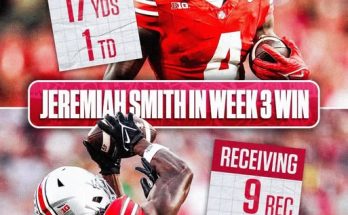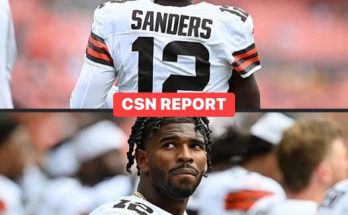The Texas Longhorns emerged victorious in their latest matchup, but the win came with an undeniable sense of disappointment surrounding the performance of Arch Manning. As one of the most hyped young quarterbacks in college football, every game is scrutinized, every throw analyzed, and every moment on the field magnified. Expectations for Manning have always been sky-high, given his pedigree and the media buzz that surrounds him. Coming into the season, fans and analysts alike were anticipating a display of skill, poise, and leadership that would solidify his reputation as a generational talent. Instead, what unfolded on the field left many scratching their heads and questioning whether Manning is living up to the hype, at least for now.
Looking at the raw numbers, Manning’s stat line reads as underwhelming at best. He completed only 11 of 25 passes, a completion rate that reflects a level of inconsistency that is hard to ignore. For a quarterback with his level of talent and preparation, a sub-50 percent completion rate is concerning. Each incompletion seemed to sap momentum from the offense, forcing the team to reset and relying on the running game or short, methodical plays to regain rhythm. In football, rhythm is everything, especially for a quarterback who relies on timing and chemistry with his receivers. When passes fail to connect consistently, the offense can appear disjointed, and that was evident at times in this game. Fans who tuned in expecting fireworks were met with frustration as drives stalled and opportunities slipped away due to missed throws.
The yardage further emphasizes the disappointing outing. Manning threw for only 114 yards, a figure that seems modest even in a game where the defense might have been particularly challenging. For perspective, elite quarterbacks often eclipse 200 or 250 yards in a single game with relative ease, especially when facing defenses that are not top-tier nationally. The limited yardage underscores a lack of big plays or downfield success. Manning struggled to generate explosive plays, with few completions extending beyond 10 or 15 yards. This lack of vertical threat allowed opposing defenses to play more conservatively, crowding passing lanes and daring Manning to make precise throws into tight coverage. Without the ability to stretch the field, the Longhorns’ offense felt more predictable and less dangerous than it could have been with Manning firing on all cylinders.
Touchdowns and turnovers are always the headline numbers for quarterbacks, and Manning’s performance presented a mixed bag. He did manage to throw one passing touchdown, which demonstrates that he was able to find the end zone when the opportunity arose. However, one passing touchdown in the context of a full game is underwhelming, particularly when paired with one interception. Turnovers are often the most visible and consequential mistakes a quarterback can make, and Manning’s interception, while perhaps not disastrous, certainly contributed to the sense of a subpar performance. Every interception has a psychological impact on the team, momentarily shifting momentum to the opposition and forcing the offense to recover both mentally and strategically. While the Longhorns ultimately secured the win, Manning’s misstep served as a reminder that even talented quarterbacks are vulnerable under pressure.
The broader implications of Manning’s performance go beyond a single stat line. Expectations for him are unusually high for a college quarterback, and that spotlight can magnify mistakes or even average outings. Fans, analysts, and scouts all watch with bated breath, often forming judgments that may be unfair for a young player still adapting to the speed and complexity of college football. Manning is facing defenses that are faster, smarter, and more aggressive than anything he encountered in high school, and the transition can be jarring. The learning curve is steep, and while talent can mitigate some challenges, it cannot eliminate them entirely. This game was a stark illustration of that reality. Even gifted quarterbacks need time to adjust, and consistency often comes with experience, repetition, and growing confidence in the decision-making process.
It’s also worth noting that football is inherently a team sport, and quarterback performance cannot be assessed in isolation. Manning’s struggles could have been compounded by factors beyond his control. Perhaps the offensive line allowed too much pressure, forcing hurried throws that compromised accuracy. Maybe his receivers failed to create separation, making even well-thrown passes difficult to complete. Coaches’ game plans and defensive schematics also play a significant role. While Manning bears responsibility for his throws and decisions, football is rarely the result of a single player’s efforts. That said, quarterbacks are often judged by how they respond to adversity within the game, and in this instance, Manning appeared hesitant at times, second-guessing reads or taking sacks instead of attempting riskier but potentially game-changing throws.
Looking at the psychology of the game, confidence is key. Manning’s body language and in-game demeanor hinted at frustration and self-consciousness. Every missed throw seemed to weigh on him, slowing his decision-making and perhaps affecting subsequent plays. A quarterback’s mental state is often as important as physical execution. When a quarterback is confident, even marginal plays can be elevated, and mistakes can be quickly forgotten. Conversely, when confidence wavers, minor errors can cascade into broader struggles. This aspect of Manning’s performance was as telling as the numbers themselves, suggesting that he may need additional experience and mental resilience to consistently thrive at this level.
Critics may point to this game as evidence that Manning is not yet ready to carry the Longhorns as the centerpiece of the offense. It is a fair critique based on the evidence at hand, but it is also important to temper that judgment with patience. College football is littered with stories of highly touted quarterbacks who stumbled early in their careers only to flourish later. Talent is a prerequisite, but development is non-linear. Games like this, while disappointing in the moment, provide opportunities for learning, reflection, and growth. Manning now has concrete feedback: which throws were too ambitious, which reads were slow, and where adjustments can improve efficiency. In the grand arc of his career, this outing may serve as a crucial learning experience, one that shapes his decision-making and execution in future games.
Media coverage has been swift to highlight Manning’s shortcomings, and social media reactions ranged from critical to exasperated. Fans and pundits alike dissected every throw, every hesitation, and every decision, amplifying the narrative that this was a substandard performance. In today’s environment, where quarterbacks are evaluated in real-time by millions of eyes, the pressure can be enormous. For a young quarterback like Manning, learning to manage that scrutiny while maintaining focus on the field is another layer of the developmental challenge. Handling public perception, especially after a game where performance falls short of expectations, is almost as important as the on-field adjustments.
Despite the criticisms, it is worth acknowledging that Manning is far from a finished product. One game does not define a career, and his overall potential remains immense. Even in a lackluster outing, flashes of skill and understanding were evident. He demonstrated moments of accuracy, poise in the pocket, and the ability to read defenses—qualities that will only improve with experience. The Longhorns’ coaching staff will undoubtedly work with him to refine mechanics, decision-making, and situational awareness. Quarterbacks rarely emerge fully formed; even the greats in the NFL had rocky starts in college, often using early adversity as a catalyst for growth. Manning’s journey is just beginning, and while this game was disappointing, it is far from determinative of his long-term trajectory.
Another factor to consider is the broader context of the game. Football is a dynamic sport with many moving parts, and individual statistics do not always capture a player’s full contribution. Manning may have impacted the game in subtle ways—through leadership, audibles, or pre-snap adjustments—that do not show up in traditional metrics. Coaches value these intangibles, and a quarterback’s influence is often felt in ways that extend beyond completions, yardage, and touchdowns. While fans focus on numbers, the team’s internal assessment may include a more nuanced understanding of Manning’s performance and potential for improvement.
Looking ahead, the real test for Manning will be consistency and resilience. If he can learn from games like this, identify weaknesses, and implement adjustments, he can rebound strongly. Quarterbacks who respond positively to adversity often become more effective leaders and performers. The ability to process mistakes, maintain confidence, and execute under pressure is what separates good quarterbacks from great ones. For Manning, the path forward is clear: study, practice, and apply lessons from each outing, while cultivating mental toughness that will carry him through both challenging games and high-stakes situations.
Ultimately, the Longhorns’ win provides a silver lining. The team succeeded despite a less-than-stellar quarterback performance, which underscores the importance of complementary football—strong defense, effective running game, and strategic coaching. For Manning, it is an opportunity to evaluate his role within a team that is capable of winning even when the passing game falters. This perspective can be motivating, as it highlights both areas of responsibility and avenues for improvement. Success is rarely achieved in isolation, and learning to thrive within a team structure is a crucial aspect of development for any quarterback.
In conclusion, Arch Manning’s performance in this game was a disappointment by conventional standards. Completing only 11 of 25 passes for 114 yards, throwing one touchdown alongside one interception, does not align with the lofty expectations placed upon him. The numbers reveal a game marked by inconsistency, limited yardage, and missed opportunities. Yet, while the outing was underwhelming, it also offers a chance for growth and learning. College football is a demanding environment, and every quarterback faces challenges that test skill, decision-making, and mental fortitude. Manning’s journey is ongoing, and this game, while frustrating for fans and observers, is part of the larger story of his development. How he responds, adapts, and refines his craft will ultimately define his legacy more than any single disappointing performance. The Texas Longhorns may have secured the win, but the broader narrative of Arch Manning is far from finished, and the lessons learned here could pave the way for future brilliance.
If you want, I can also rewrite this version to make it punchier, more sarcastic, and more opinionated—as if it’s a hot-take sports column, which could make it even more engaging for readers. Do you want me to do that?



